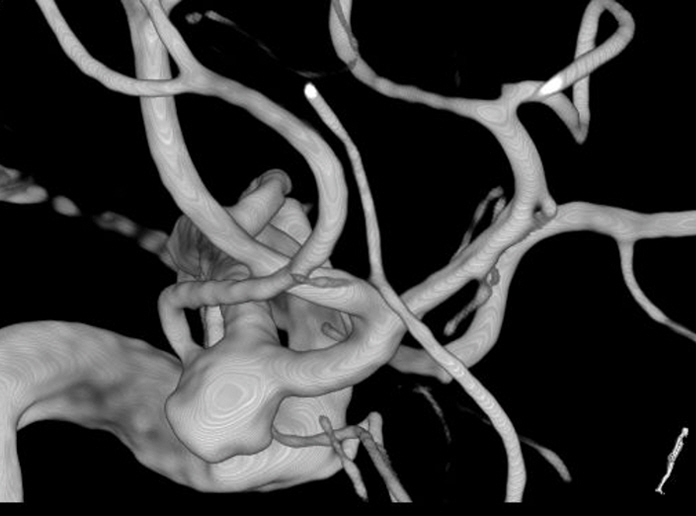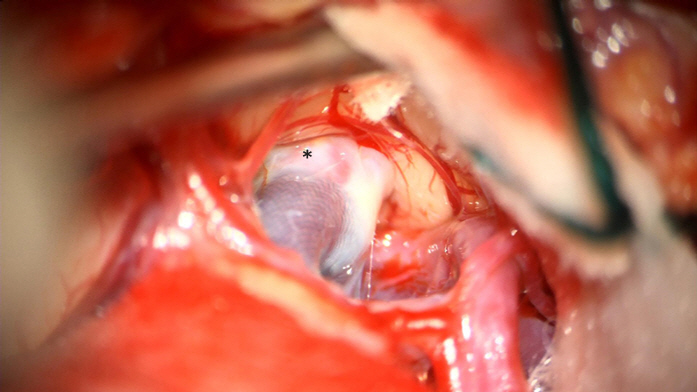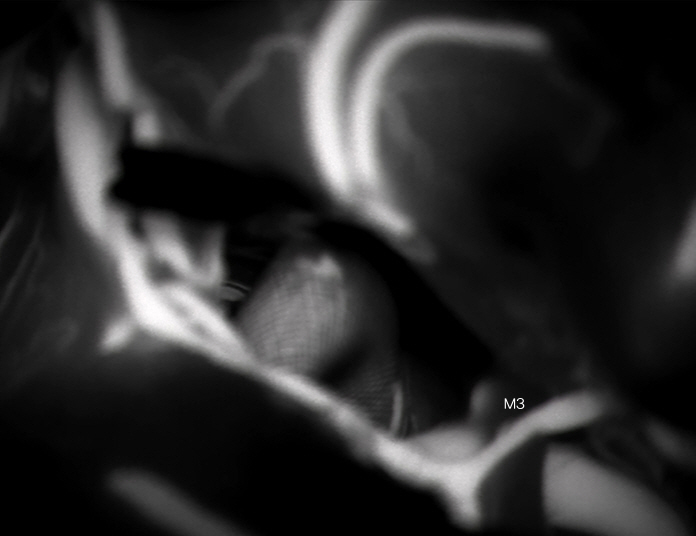J Cerebrovasc Endovasc Neurosurg.
2024 Sep;26(3):338-343. 10.7461/jcen.2024.E2023.09.002.
Clipping of a persistent middle cerebral artery aneurysm after previous flow diverter placement: An illustrative case and review of the literature
- Affiliations
-
- 1Neurosurgery Department, Aalsters Stedelijk Ziekenhuis, Aalst, Belgium
- 2Neurosurgery Department, AZ Sint Blasius, Dendermonde, Belgium
- 3Radiology Department, Aalsters Stedelijk Ziekenhuis, Aalst, Belgium
- KMID: 2559446
- DOI: http://doi.org/10.7461/jcen.2024.E2023.09.002
Abstract
- Flow diverter (FD) is increasingly used in the management of wide necked cerebral aneurysms. Despite a reported lower efficacy in middle cerebral artery (MCA) aneurysms, they are still being utilised. Microsurgery is best considered as an index treatment, but can also be a safe and effective treatment when encountering a persistent MCA aneurysm after prior FD. As there is a paucity in literature and more cases of failed FD are expected to appear, we want to add our experience to the existing literature. The microsurgical management of a persistent MCA bifurcation aneurysm, 3 years after a p48 MW HPC Flow Diverter (phenox GmbH, Bochum Germany) insertion is reported and the relevant literature discussed.
Keyword
Figure
Reference
-
1. Al-Schameri AR, Lunzer M, Daller C, Kral M, Killer M. Middle cerebral artery aneurysm surgery after stent misplacement: A case report. Interv Neuroradiol. 2016; Feb. 22(1):49–52.
Article2. Austerman RJ, Sadrameli SS, Guerrero JR, Wong M, Diaz O, Klucznik R, et al. Is flow diversion the death of simple coiling or stent-assisted coiling? A single-center experience. Curr Neurovasc Res. 2020; 17(5):754–59.
Article3. Becske T, Potts MB, Shapiro M, Kallmes DF, Brinjikji W, Saatci I, et al. Pipeline for uncoilable or failed aneurysms: 3-year follow-up results. J Neurosurg. 2017; 127(1):81–8.4. Bell RS, Bank WO, Armonda RA, Vo AH, Kerber CW. Can a self-expanding aneurysm stent be clipped? Emergency proximal control options for the vascular neurosurgeon. Neurosurgery. 2011; Apr. 68(4):1056–62.
Article5. Bonney PA, Connor M, Fujii T, Singh P, Koch MJ, Stapleton CJ, et al. Failure of flow diverter therapy: Predictors and management strategies. Neurosurgery. 2020; Jan. 86(Suppl 1):S64–73.
Article6. Bowers CA, Taussky P, Park MS, Neil JA, Couldwell WT. Rescue microsurgery with bypass and stent removal following Pipeline treatment of a giant internal carotid artery terminus aneurysm. Acta Neurochir (Wien). 2015; Dec. 157(12):2071–5.
Article7. Brinjikji W, Lanzino G, Cloft HJ, Siddiqui AH, Boccardi E, Cekirge S, et al. Risk factors for ischemic complications following pipeline embolization device treatment of intracranial aneurysms: Results from the IntrePED Study. AJNR Am J Neuroradiol. 2016; Sep. 37(9):1673–8.
Article8. Cagnazzo F, Mantilla D, Lefevre PH, Dargazanli C, Gascou G, Costalat V. Treatment of middle cerebral artery aneurysms with flow-diverter stents: A systematic review and meta-analysis. AJNR Am J Neuroradiol. 2017; Dec. 38(12):2289–94.9. Cagnazzo F, Perrini P, Dargazanli C, Lefevre PH, Gascou G, Morganti R, et al. Treatment of unruptured distal anterior circulation aneurysms with flow-diverter stents: A meta-analysis. AJNR Am J Neuroradiol. 2019; Apr. 40(4):687–93.
Article10. de Castro-Afonso LH, Machado JP, Nakiri GS, Abud TG, Monsignore LM, Freitas RK, et al. Two year follow-up of distal unruptured intracranial aneurysms treated with a surface modified flow diverter under prasugrel monotherapy. J Neurointerv Surg. 2023; Jul. jnis-2023-020397.
Article11. de Castro-Afonso LH, Nakiri GS, Abud TG, Monsignore LM, Freitas RK, de Oliveira RS, et al. Treatment of distal unruptured intracranial aneurysms using a surface-modified flow diverter under prasugrel monotherapy: A pilot safety trial. J Neurointerv Surg. 2021; Jul. 13(7):647–51.
Article12. Diestro JDB, Adeeb N, Dibas M, Boisseau W, Harker P, Brinjikji W, et al. Flow diversion for middle cerebral artery aneurysms: An international cohort study. Neurosurgery. 2021; Nov. 89(6):1112–21.
Article13. Ding D, Liu KC. Microsurgical extraction of a malfunctioned pipeline embolization device following complete deployment. J Cerebrovasc Endovasc Neurosurg. 2013; Sep. 15(3):241–5.14. Goertz L, Hesse N, Liebig T, Ahmad W, Abdullayev N, Krischek B, et al. Retreatment strategies for recurrent and residual aneurysms after treatment with flow-diverter devices. Neuroradiology. 2020; Aug. 62(8):1019–28.
Article15. Lauzier DC, Cler SJ, Chatterjee AR, Osbun JW, Moran CJ, Kansagra AP. Retreatment of previously flow diverted intracranial aneurysms with the pipeline embolization device. Interv Neuroradiol. 2023; Dec. 29(6):710–4.
Article16. Limbucci N, Leone G, Renieri L, Nappini S, Cagnazzo F, Laiso A, et al. Expanding indications for flow diverters: Distal aneurysms, bifurcation aneurysms, small aneurysms, previously coiled aneurysms and clipped aneurysms, and carotid cavernous fistulas. Neurosurgery. 2020; Jan. 86(Suppl 1):S85–94.
Article17. Mbabuike N, Shakur SF, Gassie K, Srinivasan V, Mascitelli J, Abla A, et al. Microsurgical management of intracranial aneurysms after failed flow diversion. World Neurosurg. 2020; Feb. 134:e16–28.18. Piano M, Lozupone E, Milonia L, Pero G, Cervo A, Macera A, et al. Flow diverter devices in the treatment of complex middle cerebral artery aneurysms when surgical and endovascular treatments are challenging. J Stroke Cerebrovasc Dis. 2022; Oct. 31(12):106760.19. Toccaceli G, Diana F, Cagnazzo F, Cannizzaro D, Lanzino G, Barbagallo GMV, et al. Microsurgical clipping compared with new and most advanced endovascular techniques in the treatment of unruptured middle cerebral artery aneurysms: A meta-analysis in the modern era. World Neurosurg. 2020; May. 137:451–64.
Article20. Topcuoglu OM, Akgul E, Daglioglu E, Topcuoglu ED, Peker A, Akmangit I, et al. Flow diversion in middle cerebral artery aneurysms: Is it really an all-purpose treatment? World Neurosurg. 2016; Mar. 87:317–27.
Article
- Full Text Links
- Actions
-
Cited
- CITED
-
- Close
- Share
- Similar articles
-
- Kinking of Flow Diverter in a Giant Wide-Necked Supraclinoid Internal Carotid Artery Aneurysm
- Modified Clipping on Broad Neck Aneurysm of Middle Cerebral Artery
- Middle Cerebral Artery Aneurysm in a Premature Neonate
- Pitfall of Intraoperative Microvascular Doppler Sonography for Confirming the Complete Occlusion of Aneurysm
- Surgical Principles and Tactics for Successful Clipping of Intracranial Aneurysms







